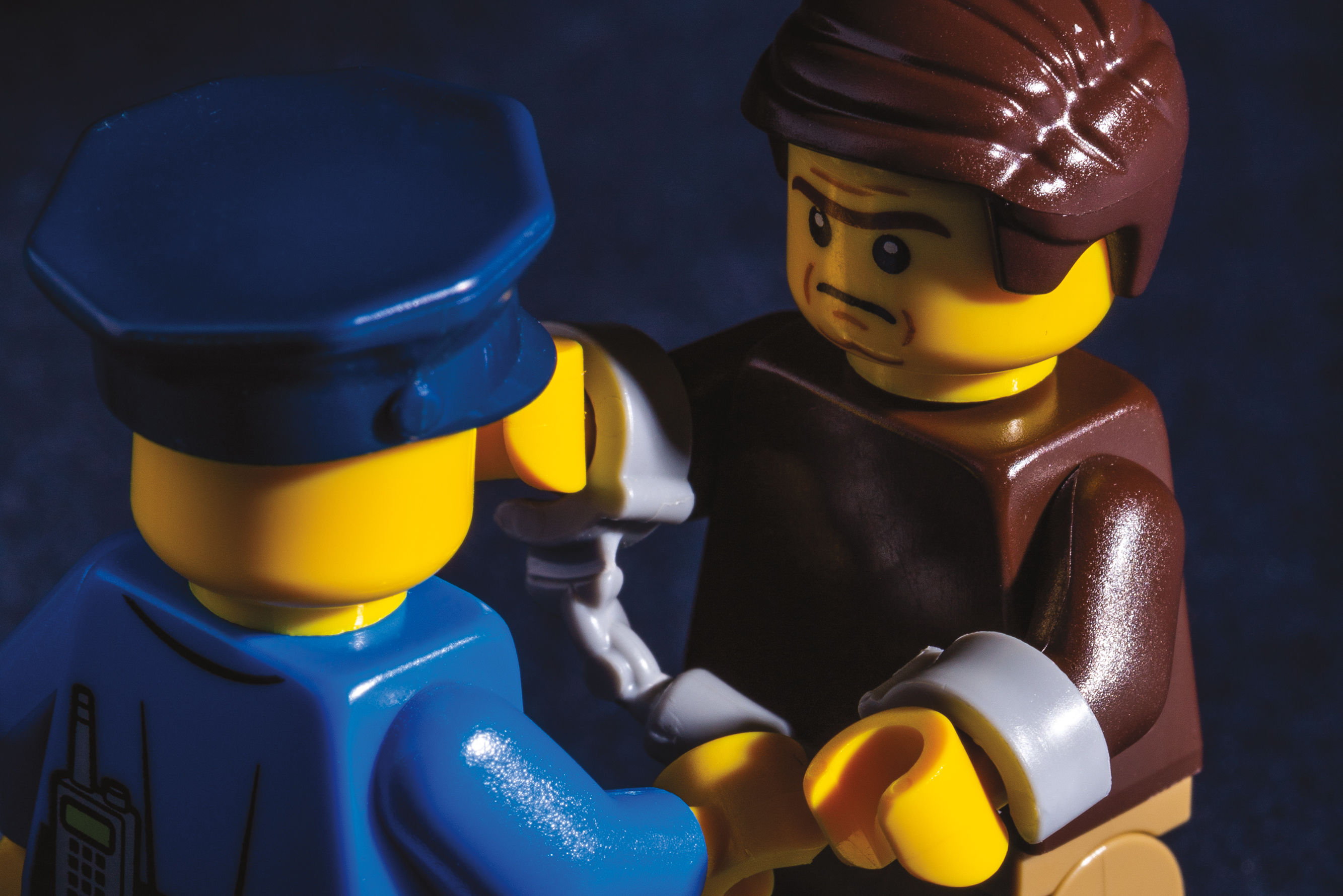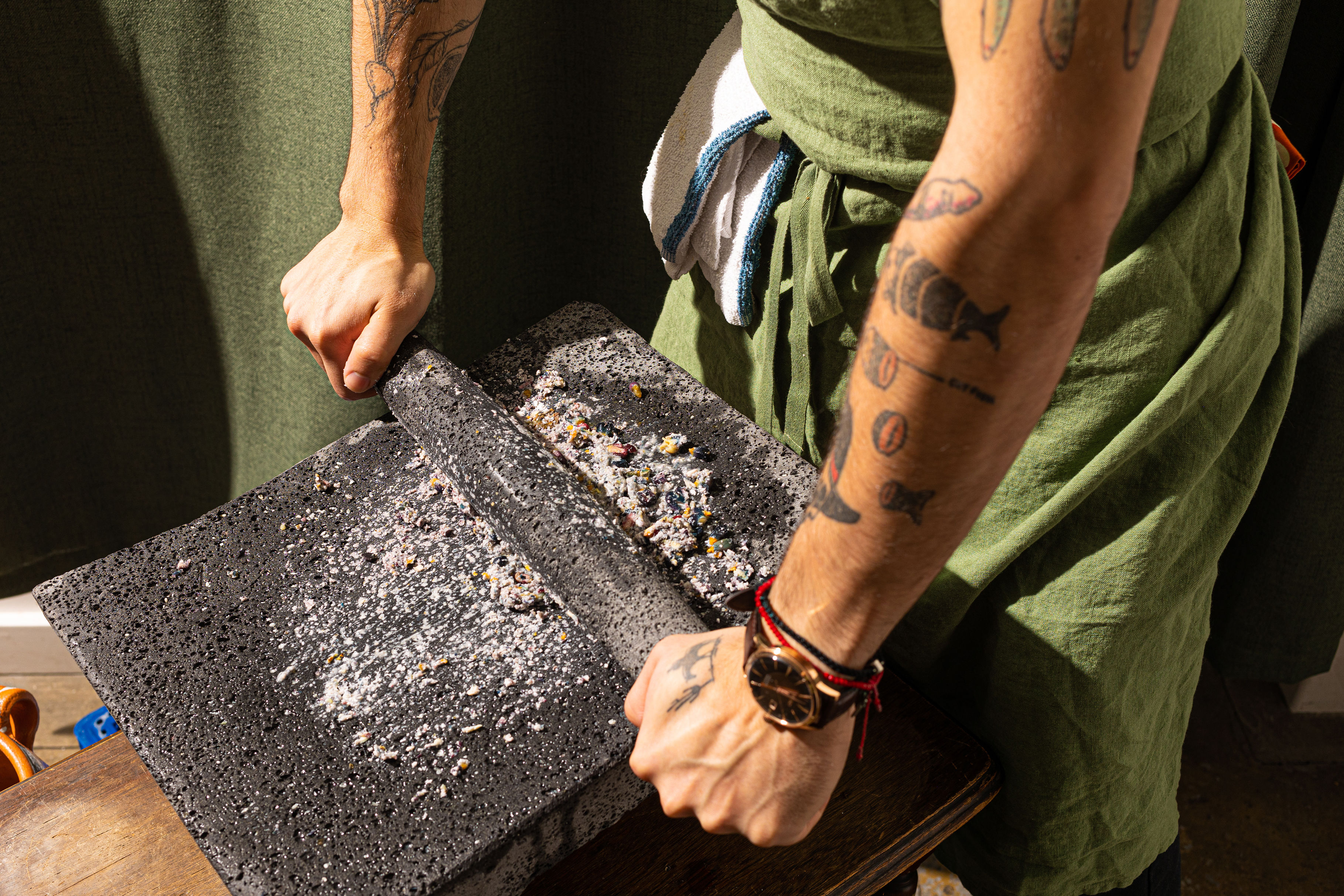
How One $50,000 Bust Revealed an Underworld of Portland Lego Crime
(Editor's Note: On January 31, 2019, a jury found Raji Afife Azar guilty of one count of laundering a monetary instrument, one count of criminal conspiracy to commit theft in the first degree, three counts of computer crime, and seven counts of attempted theft in the first degree. Sentencing will be held on February 15.)
The Legos were stacked nearly up to the ceiling of Raji Afife Azar’s Southeast Portland garage. Boxes upon boxes upon boxes of Lego collectibles: a Batcave, Star Wars U-wings and Jakka Quadjumpers, 1962 vintage VW campers complete with pop-up roofs and folding furniture, and Ninjago temples—each in pristine, unopened condition. All told, police put the value of these sets at more than $50,000. And every single, tiny brick—batwing to Obi Wan’s hyperdrive ring—was allegedly contraband. The cops had just cracked the case of Portland’s Brick Baron.
Sure, $50,000 in Lego bricks isn’t exactly a major haul compared to, say, the $2 million of meth and heroin Portland police recovered in a single bust in 2017. But in a metro area that supports not one but at least five Lego-specific stores, a nationally recognized adult builder community, and an annual build convention that draws 8,000 adults and kids, stealing blocks is a big deal.
It went down last winter, when police say Azar—a 40-year-old who worked at Providence Medical Center in Northeast Portland—posted an ad online, offering to buy new or "like-new" Lego sets and loose Lego minifigs from anyone willing to sell. The ad caught the attention of Safeway and Fred Meyer “loss prevention” detectives—particularly because the ad included an offer to pay just 30 percent of the sets’ retail price, a remarkably low figure for high-priced toys increasingly coveted by collectors. Indeed, over the past decade, demand for Legos has risen 15 percent—straining, by one report, the Danish company’s ability to produce enough plastic blocks. Why would anyone sell Azar their sets for that cheap? Unless ... the product was hot. Store detectives tipped off the police, who decided to set a trap.

Raji Afife Azar
In January 2018, police responded to the ad, and two undercover cops eventually sold Azar several Lego sets (as well as two boxes of Gillette razor cartridges). Perhaps as an enticement to steal more sets, Azar assured the cops the Legos were “easy to get” and said he would compensate them for whatever they could bring him. Loquacious in his text messages, Azar bragged he would sell them on eBay for a higher price. When Azar saw that the Lego sets clearly still sported Fred Meyer’s yellow anti-theft tags, police say, he shrugged. He didn’t mind, he told his new suppliers, according to later court filings.
The undercover cops continued corresponding with Azar online until April 2018, when, after a $13,000 sale of merchandise, they arrested him. Inside Azar’s home on SE 102nd Avenue, police discovered his plastic stash, all destined to be sold online. In May, the State of Oregon formally charged him with first-degree theft, money laundering, criminal conspiracy, and felony computer crimes. (The DA’s office would not comment on jail time. None of Azar’s charges carry mandatory minimum sentences.) In an early affidavit, deputy district attorney Sean Hughey alleged Azar was a fence, buying stolen Lego sets for well-below retail price and then flipping the sets online through OfferUp and eBay. The outcome of his trial, scheduled for early January, was unknown at press time. But it sure does look like the blocks are stacked against him.
It’s 10 a.m., and Bricks & Minifigs on NE Sandy Boulevard is already bustling. Kids roam the shelves eyeing Star Wars sets while adults paw through giant bins of loose bricks. The store, which includes completed R2D2s and a five-foot, 125-pound custom Lego robot near the entrance, is as close to a Lego wonderland as you’ll find around here—one of four Portland-area locations of a Canby–born franchise that has exploded to 40 stores nationwide in just a decade.
Owner Spencer Crandall, sitting in a back room reserved for Lego building projects, says he knows all about “garage guy”—as he calls Azar—and his shifty business. In his three years running this store, Crandall says he’s turned away many people trying to sell him stolen Legos, from brand-new sets with Fred Meyer price tags still on them to loose bricks and finished display models stolen from homes. Recently, he said no to a sketchy seller who’d arrived in a truck loaded with two suitcases full of bricks.
“You can usually spot them. [The sellers] tend to be kind of thin-looking, a little dirty,” he says. “It’s probably a drug-type situation and they’re trying to just get some cash. When we first opened, we got more of those people. As time went on, we’ve gotten less and less because they understood, ‘Oh, they’re not going to buy it.’”
Crandall’s eye for shadiness was probably a reason for Azar’s alleged success. As a fence, Azar would likely have been buying stolen Lego sets from the kinds of individuals Crandall turned away. Though sets can be expensive (see box below), Legos have no built-in tracking information. Police and attorneys declined to be interviewed for this story pretrial, but according to hobbyist experts Lego snatching is a crime that happens all around the world—and frequently nabs headlines. In May 2018, two English women were arrested in Poole, England, for stealing £2,000 worth of bricks. In September, a 79-year-old woman was arrested for shoplifting a Lego set from a Target in Sumter County, Florida, northwest of Orlando and about 70 miles from the Legoland theme park.
“It’s unfortunate and not surprising,” says Kelley Baek, a member of Portland adult Lego hobbyist group PortLUG. “When you have a fairly high-value item that’s readily accessible and not easily traceable, it’s not shocking that folks take advantage of that. [This crime] was maybe on a larger scale than people would have thought, but theft is a pervasive challenge.”
Collectors like Allen Tran, of San Diego–based site thebrickfan.com, say that while the initial lifting might be a cakewalk for Lego thieves, the next step—courting buyers—can often reveal the crime. “If the price is too good to be true, it might be stolen,” Tran says. “For example, a set that normally would retail for $200 and someone tries to sell for less than what they could get it for on eBay is probably stolen.”
Indeed, this isn’t even the first time such a caper has gone down in Portland. In 2016, Pavel Ilich Kuzik, then 25, was arrested for a crime eerily similar to the one Azar is accused of: he was picked up following a sting operation that also recovered around $50,000 in stolen Legos. A representative for the district attorney’s office is unsure why Kuzik’s case wasn’t prosecuted—and, curiously, Azar mentioned to undercover police officers during his subsequent sting that he had a onetime associate who was caught by the police. (Kuzik has since been arrested for other crimes, including identity theft.)
Perhaps Portland is a hotbed of Lego theft because the Lego community here is so active—especially among adults. According to Baek, most major cities have a “Lego user group” (LUG)—a fan community primarily for adults to socialize, exchange bricks and minifigs, and build together. But the PortLUG’s 350 active members place it high on the national ranking. Bricks & Minifigs caters not just to kids and families, but also to a sizable base of adult fans, collectors, and “investors,” who view unopened sets as tradable commodities. If the vibrancy of Portland’s Lego scene itself encourages thieves, it’s not, says Baek, the community most affected by black-market Legos; those would instead be parents and other casual Lego buyers.
“My gut is, from talking to fellow [PortLUG] members, the victims aren’t usually the hard-core Lego fans,” says Baek, adding that legitimate resellers usually use sites like bricklink.com rather than OfferUp, eBay, or Craigslist. “It’s often, you know, Grandma just wants to get this hot set for a kid for Christmas and they’re willing to pay whatever price.”
Baek, a business manager at Nike, says she initially started building with her two kids. Her personal obsession has now taken over the family basement. (Ahead of next month’s Bricks Cascade exhibition at the Oregon Convention Center, she’s building a re-creation of the town of Sweetwater from HBO’s Westworld, complete with a working, programmable train.) As Baek explains, Lego is the perfect toy: creative and infinitely reusable: 40-year-old pieces will work just as well as four-day-old ones.
For Crandall, who says he fields calls from reporters whenever a new Lego bust goes down, the focus on Azar’s alleged crimes obscures the real story: why Legos are such a blockbuster in the first place.
“I’ve never been interviewed about, like, the joy of Lego and the Lego community, and why people love Lego,” Crandall says. “But that’s really what it’s about: not why they steal it. Why do they love it? And it happens to be that the reason people steal Lego is because people love Lego. It’s creative and it does all these things that other toys don’t do.”
Gold Bricks: 3 Legendary Lego Sets
Some collectors build their sets to display on shelves. Others keep them in boxes in pristine condition, just to have them. Still others buy bricks in sets and mix them up to make their own creations. Either way, some Legos are more prized than others. “There’s quite a few coveted sets, some vintage, some contemporary,” says Tommy Williamson of Lego news and tips site BrickNerd. “When a popular set gets ‘retired,’ especially when it was a limited production run, it instantly becomes coveted.” While many sets approach the $1,000 mark—from architectural masterpieces like the Taj Mahal to licensed sets like the Batman series—prices vary greatly per vendor or due to set condition and age. Here are three of the most iconic sets sought by collectors.

Image: Courtesy Toys Period, Courtesy Cafe Corner, and Courtesy Cata Wiki
375-2 Yellow Castle
Up to $250 used
Released in 1978, this somewhat dated-looking set features knights on horseback in a small mustard-tinted fortress. As one of the first themed sets, it’s highly prized as a piece of Lego history.
10182-1 Café Corner
Up to $500 used
This ridiculously adorable little three-story, Parisian-style corner building includes a café on the ground floor—complete with a tidy proprietor in an apron—with hotel rooms above.
10179 Star Wars Millennium Falcon
Up to $600 used
This original “Ultimate Collector Series” spaceship, released in 2007, is the most spendy out there. The enormous set has 5,174 pieces and features Han Solo and Chewbacca minifigs.




